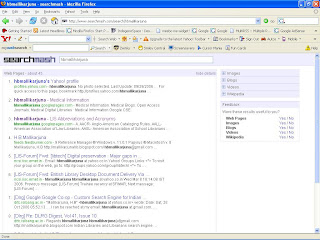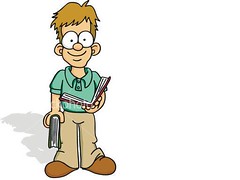
"Right information to the right user at the right time in right personal way"
-
S.
R.
Ranganathan
Library users are changing ...., Technology ...,information storage media...changing , changing .................but librarians are not changing ...why?
in this trend ....
Megan Fox take one more step ahead ......... Mobile Tools & Applications for Libraries
by
Megan Fox presented in Internet Librarian 2006excerpt: (Notes by Kate Carter )
"Megan Fox, Web & Electronic Resources Librarian, Simmons College Fox provides a fast-paced overview of the current hardware available and how new technologies are making hand-held computers not just palatable but preferable for on-the-go users. She highlights the latest developments in applications for mobile and hand-held tools, and how these can and are being utilized by libraries and information seekers of all kinds. Come hear what’s happening with traditional information vendors and mobile interfaces, the mobile optimized Web, point-of-need answers, reference texting, and multimedia (such as podcasting and location-free TV) for your mobile device.
Relevant Notes:General- Patrons want answer at moment of need
- Flexibility - don’t want to be limited to what they have and lug around with them
- Gratification anytime anywhere on one’s own device
- Handheld market – 90% of college students have cell phones, 62% of all users use text messaging
- Phones used to be for spoken word communication, but no more
- our stuff is 5-7 years behind Asian market – they have live tv (picture in picture), etc.
– our current mobile network can’t support advanced stuff like video conferencing yet
Latest mobile devices -
Palm Treo;,
Nokia N Series: N92 & N93 (can upload and add comments to flickr directly from phone, can plug into tv, can connect wirelessly or with bluetooth to printer)/E70/9300 Communicator; Smartphones (has many more features – integrated, converged, multifunctional), Samsung SPH-B5200/SCH-B470;
Sony Ericsson-
Ultra-Mobile PC by Microsoft – full windows XP machines – 7 inch or smaller screen, 2 pounds, $500-$100 dollars, touchpack program – bigger scrollbars etc. so that you don’t need a stylus (battery life too slow – 2 hours), if Microsoft is in on this then libraries need to be too (?)
-
Sony Mylo – wifi broadband communication and entertainment device (my life online), yahoo messenger, google talk, skype, 7 hours of websurfing with battery! To stay connected without a laptop
Mobile Optimized Web- Wifi or other means to connect directly to the internet
- Many websites are intended for large screens, and large screens can’t handle it
- Mobile device optimized – no flash, javascript, no data entry, simpler code, smaller text
-
.mobi internet domain
- Stanford – simplified access. Smarter searching. – hours, stack locations, etc.
- Many sites will recognize device and serve that content to you
- Tvguide.com (still has mini ads) – busy v. stripped down verios for mobile devices
- Hoovers, NYT, PubMed, Library Thing, Mobizines
- Requested Re-formatting of Content –
skweezer,
IYHY,
Google mobile optimizer (translates it to mobile content), AOL also – but you might lose content, transcoding - criticism - h(ijacking content by providing generically modified version)
-
Mob5- Moblogs
Blogger Mobile,
Splashblog,
ShoZu- RSS to mobile:
Feedbeep,
mobifeeds,
hubdog,
xfruits- Mobilizing mashups –
frucall,
jobster,
kmaps,
gcalsync,
programmableweb.comContent on the Go- Library catalog – even have access to circ module for staff
-
Handango – ready reference on the go, aol mobile, google,
Yahoo! Go: for definitions, sports scores, nearby restaurants movies etc., mobile answer engines NOT search engines – return answers not lists of links - most 411 callers are from cell phones (people want info on the go)
-
Answers.com – “pre-search market”,
Ask mobile content
Taking ebooks with you-
Mobipocket, M
any Books- Univ. of Alberta – instructions for NetLibrary to pda
Handheld database access- Ovid, Pubmed (health and medical fields)
- LexisNexis partnership w/ blackberry
- Factiva
Content via SMS/Texting- Erratic wifi access, only 4% of American households report using phone internet regularly
-
Google SMS - text 46645 – answer to movie time, etc.
-
Synfonic-
AskMeNow-
HarperCollins Australia – sends bits of new books to phone
- Sites have IM to a friend option or send to phone – “should this be on catalog results pages?”
Communicating with Mobile Users- Chat & Email - young people prefer textting and IM - sense of control, speed, brevity, more authentic version of self
- “
Email is for old people”
-
Reference by SMS - Altarama.com.au/refxsms.htm – text message sent to librarian email – librarian replies with less than 256 characters which goes to users device again – stays within current workflows of librarians
-
Vazu,
Teleflip,
Joopz – email translated into text message
- Innovative will offer texting in the next releases – overdue notices
-
E2campus (Penn State)
- “
Cingular & Rave Wireless Provide Innovative Wireless Solutions Tailored for Colleges & Universities” (pdf)
- Sync calendar to turn off phone when in class
Mobile Audio- 70% of all music downloads occur on mobile devices in Asia
- E-audiobooks
- iPod suffles preloaded with books and just check out entire device
- Every listening device for every class loaded onto 40gb ipods
-
Audible.com,
fonpods-
LibriVox – audio version of project Gutenberg
- Tours with mobile devices
Mobile multimedia - video- 20 million users expected by the end of 2007
- Location free tv – mainly Sony devices
- DVR – like TiVo, expected on mobile devices in 2007
What’s next?- Effective use is still hampered by uncomfortable entering of letters
- Camera feature to start a query with an image – picture of movie poster returns movie listings (mobile visual search, photo to search)
-
Promptu for Mobile – spoken words prompted search (could you say catalog to your phone and get the catalog?)
- Point and Click - stand in front of building, point device at it and get info about it, geotagging/GeoVector, could devices senses where you are and automatically open the library catalog?, Semapedia.org
- Use camera for face recognition instead of passwords
-
Amida simputer – turn page of the ebook with a motion
one more good article "E-mail: A Tool for Exchange of Information in Libraries -"
by R. P. Upadhye, Minati MandaI, Tara Ashok and Vijay Kumar
excerpt "The basic objective of a library is to acquire, process and disseminate right information to the right user at the right time. In order to achieve these objectives, librarians have been adopting various tools and techniques offered by information technology from time to time. For communication purposes, libraries have been using telephone, telex, facsimile, etc. But now computers and telecommunication technologies have brought revolutionary changes in the communication process by providing E-mail which is quicker, convenient and more cost effective than most of the other modes of communication. Applic~tion of E-mail in library communication would enable the library and information professionals to meet the information needs of the information seekers by providing timely and qualitative services. There have been proposals to have round the clock librarianship [I] and extended library hours [2]. The aim of present libraries will not only be up-to-date but up-to-the-minute information [3]. The Five Laws of Library Science propounded by Dr. S.R. Ranganathan are profound and most relevant to the current context of advancements in the frontiers of information technology........................"
Full Article: http://eprints.rclis.org/archive/00003075/01/pdf.pdf















